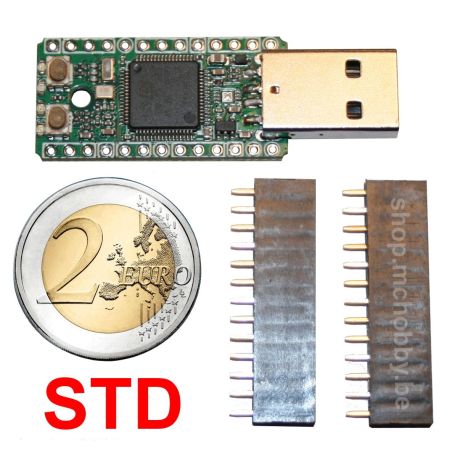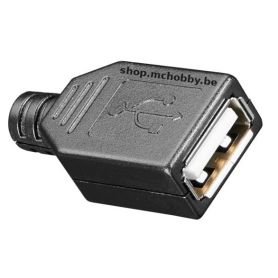PYBStick Standard 26 - MicroPython and Arduino
PYBStick Standard 26
- MicroPython and Arduino Ready
- 26 pins
- STM32F411RE
- 512 Ko Flash
- 128 Ko RAM
- SD Card installed
Payments are secured by LyraCollect, a French payment collection company.
It is possible to delivered to your home, to a pick-up point or picked up by appointment at MCHobby
We prepare, pack and ship your orders with great respect and care.
A MicroPython / Arduino compatible board affordable to create all your project - welcome to the PYBStick standard
The PYBStick card is a joint project of Garatronic and MCHobby. We wanted to make a MicroPython board sufficiently affordable, practical and well documented in French to be able to be included in all projects without having to worry about the price. We did it, it is the PYBStick in Lite and standard version. The platform includes a powerful STM32, which allows to have a powerful platform supporting both Arduino IDE and MicroPython ... what more? The Program magazine! It is joined to our adventure to make PYBStick accessible to as many people as possible.
This product is a PYBStick Standard 26 and is propel by a STM32F411 at 100 MHz, a more powerful microcontroller than the Lite version, with 512 KB of Flash and 128 KB of RAM. It is the same family of microcontrollers as the original MicroPython Pyboard, which provides excellent MicroPython support for the platform.
The PYBStick Standard 26 offers a 26-pin interface (compatible with the Lite version):
- 17x GPIO
- 8x analog input (ADC)
- 15x PWM output
- 3x serial port (UART)
- 2x I2C bus
- 2x SPI bus
- compact size
The PYBStick board is available in 4 versions PYBStick Lite, PYBStick Standard (this product), PYBStick Pro and PYBStick Duino (arduino only).
On the MicroPython side, the board can be equipped with the USB connector (type A) allowing direct connection of the board to a computer to be programmed. This product is presented like a USB key ... the memory of the board is presented like a Flash reader thus making it possible to directly edit the Python scripts on the PYBStick. The USB interface also allows the PYBStick to expose a serial port to communicate with the computer as well as an interactive Python command interpreter called REPL.
The REPL command interpreter allows:
- To see the messages displayed by your MicroPython scripts,
- Interact with your scripts during operation (stop the script, inspect the state of variables)
- Test scripts under development (import on the fly with the import command).
- Enter Python instructions to test functionalities of the microcontroller platform interactively.
On the Arduino IDE side, simply connect the platform to your computer, place it in programming mode and then start the compilation and upload of your Arduino sketch. Garatronic has provided instructions for installing the Arduino IDE support for the PYBStick.
Inexpensive and multi-use
The PYBStick was designed around several key points.
- Oriented towards Makers
- Oriented towards learning and school
- Oriented towards production
The price is low enough not to have to think before including the PYBStick in a project or another.
It is possible to request PYBSticks with the USB not soldered to allow integration into your projects with a minimum obstruction. On the learning side, this allows you to deport the connector, consider putting it in a case or even consider another USB connection.
GPIO connectors have a standard impaction of 2.54mm. This will delight all makers, teachers because it is easy to place the board on a breadboard or a Perfboard. And as the board is 13 pins wide, we are still smaller than a consumer USB stick.
User interface included
The board provides three colored LEDs as well as a user button and a DFU button (to update the MicroPython/Arduino firmware but also usable as a user button).
Their use is documented in the MCHobby Wiki (see tutorial section).
Also for professionals
The space between the two rows of connectors corresponds to the DIL dimension of the old EEPROMs. So, you can develop your own boards by providing an already standardized connector. It only remains to connect your PYBStick to it.
The board can be obtained with a non-soldered USB Type-A connector, more suitable for the professional world or the advanced makers ... here which allows to have a very powerful and very compact solution but remaining easy to implement.
Why a USB Type-A?
It is true that it seems strange but there are several good reasons for this.
- Powerbanks have standard USB. So the project can easily be powered by plugging it into a PowerBank.
- USB A allows direct use of the PYBStick as a USB 'mass storage' device, HID device (keyboard, mouse) or serial device (virtual serial port).
Just put it on the PC or a USB HUB and let's go.
There is a copy/paste example in the book "MicroPython et Pyboard" as well as on the GitHub PYBStick-project. - The USB-A is mechanically very robust, ideal for education/learning where the first manipulations are sometimes rougher.
- Because it is possible to obtain the PYBStick without the welded connector, the user thus conforms to the choice of connector desired for experienced makers.
Content
For each order, you will receive the PybStick board, two rows of female connector and the USB type A connector welded on the board. You can solder the female connectors and the USB connector on the board according to your needs.
Technical details
- Dimensions: 28x35mm (without USB), 28x50.5mm (with USB)
- Thickness: 6mm (without USB), 7mm (with USB)
- 3.3V 300mA regulator
- 350mA max, 580mA over-current shutdown
- VIN max 18v
- ME6215C33 datasheet (voltage regulator)
- STM32F411RE datasheets
- Firmware MicroPython v1.20 for PYBStick 26 F411
Tutorial
The PYBStick board has MicroPython tutorials on the MCHobby Wiki. All the knowledge available on the Net around MicroPython also applies to this product.
- PYBStick GitHub (MCHobby, English and French)
Pinouts, libraries, ressources - Projects with PYBStick under MicroPython (MCHobby GitHub, French)
- Wiki of the PYBStick under Arduino (Garatronic, French)
- Wiki of the PYBStick under MicroPython (MCHobby Wiki, French)
A set of tutorials to discover electronics under MicroPython with the PYBStick. - 3D PYBStick case (Thingiverse)
To print yourself.














